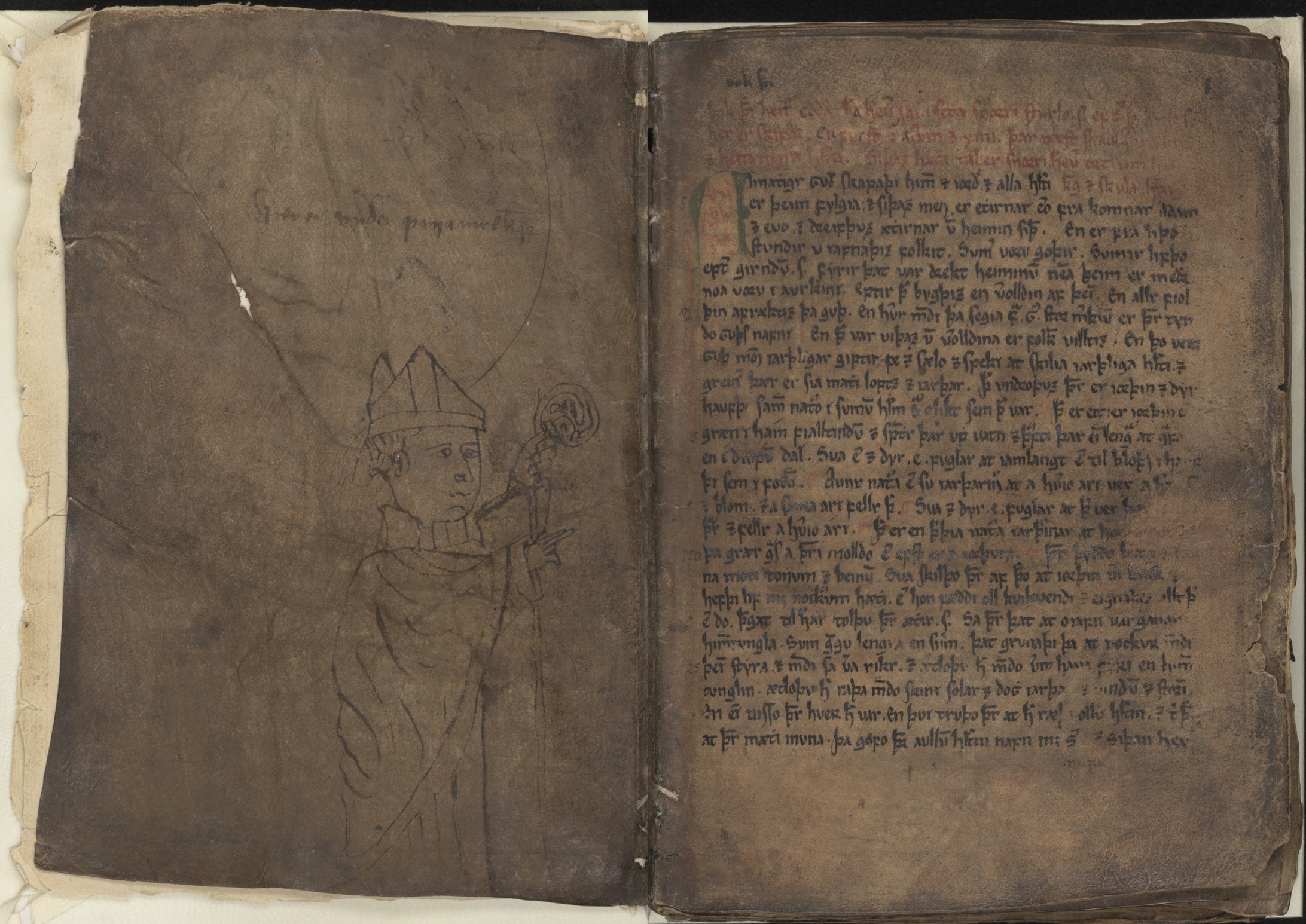The earliest evidence of pagan Norse belief systems comes from Viking Age objects that pre-date the rise of Christianity in Scandinavia. Our interpretations of these objects have long been informed by the earliest textual evidence on Norse mythology, however, this must be done with a degree of caution. Why? The earliest written sources on Viking mythology, the Poetic Edda and Snorri’s Prose Edda, were recorded in circa 1220 and 1270, respectively (Franks 2019).

Codex Upsaliensis,
one of the earliest surviving copies of the Prose Edda.
(source: Alvin)
Not only was the Lejre figure made three centuries before these texts were written, but our earliest records of Norse mythology—the Eddas included—come from Christian sources. This makes it incredibly difficult to discern which elements are most accurate to pagan Norse belief systems, which elements may have simply transformed as they were transmitted orally over time, and which elements may have been directly edited in text to fit with a more Christian worldview. Still, these textual sources are incredibly important to building out a more expansive understanding of Norse mythology. In other words, we have to work with what we have! To be fair, however, Price argues that “fortunately for Viking scholars, Snorri’s loyalty to the idea of Scandinavian monarchy gifted us a trove of knowledge” (2020, pp. 33). Although Snorri was from Iceland and recorded his texts there, his interest in historic monarchies may be particularly useful when analyzing the Lejre figure, given claims that the site is linked to early Danish nobility.
Throughout the exhibit, references have been made to conclusions that have been drawn based on textual evidence. All of the instances where this occurs can be found below, where the related textual evidence is cited and analyzed.
Geri and Freki
Just as there are limited depictions of Geri and Freki in Viking art, they are not mentioned very frequently in early textual sources. In Snorri’s Edda, Geri and Freki are described in an answer to a question about whether Odin eats; the answer given is that “the food that stands on [Odin’s] table he gives to two wolves of his called Geri and Freki. He himself needs no food: wine is for him both drink and meat” (Sturluson trans. Faulkes 1995 pp. 33). For the most part, however, wolves seem to act as threats in many of the earliest recorded Norse myths. In the Völuspá, for example, Loki leads Muspell’s demons, monsters, and the Wolf” into battle against Odin and the other Gods in Asgard (trans. Terry 1990, p. 6).
Huginn and Muninn
Odin’s ravens Huginn and Muninn are described in a few of the early textual sources on Norse mythology. In our analysis of the birds on the Lejre figure, we noted that their beaks are closed, and that they sit on the armrests of the chair. This could potentially be an important difference between visual and textual evidence because Snorri writes that Huginn and Muninn “sit on [Odin’s] shoulders and speak into his ear all of the news they see or hear” (Sturluson trans. Faulkes 1995, p. 33). It could also potentially be an indicator that the person in the Lejre figure is not Odin but another figure associated with birds.
Hildskjalf
In Snorri’s Edda, he describes the creation of the world according to Norse mythology in a text titled Gylfaginning, translated as “The Tricking of Gylfi.” According to the text, the Viking believed that the earth was created in different regions, each originating from part of the body of the giant Ymir. The Völuspá in the Poetic Edda similarly describes the Norse’s different regions of the world. The speaker of the poem makes the statement “I know how nine roots form nine worlds under the earth / where the Ash Tree rises” (trans. Terry 1990, p. 1).
Franks, Amy F. 2019. “Valfǫðr, Vǫlur, And Valkyrjur: Óðinn as a Queer Deity Mediating the Warrior Halls of Viking Age Scandinavia.” SCANDIA: Journal of Medieval Norse Studies 2: 28–65. (online)
Price, Neil S. 2020. “The Home of Their Shapes.” In Children of Ash and Elm: A History of the Vikings, 31–63. New York: Basic Books.
Sturluson, Snorri. “Gylfaginning [The Tricking of Gylfi].” In Edda, translated by Anthony Faulkes, 7–54. London: J. M. Dent, 1995.
Terry, Patricia, trans. 1990. “Völuspá.” In Poems of the Elder Edda, 2nd ed., 1–10. Philadelphia: University of Pennsylvania Press.
« Previous | Home | Next »